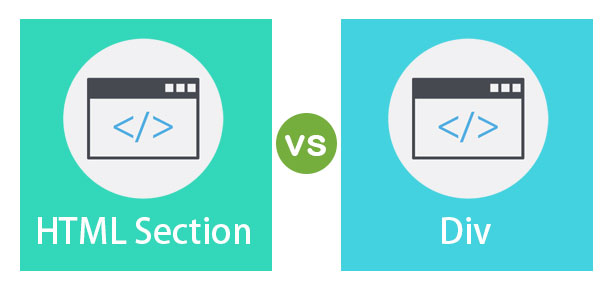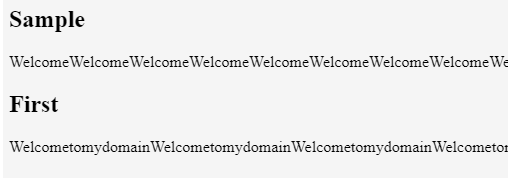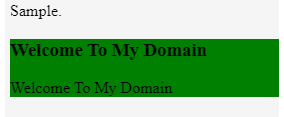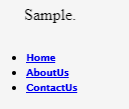Updated March 28, 2023
Difference Between HTML Section vs Div
Div is the Tag that is defined as a division of the Html document. It is mainly used to group of the block elements mainly; it will be used for the CSS Style sheet whenever we use it on the Html page. The section is also a Tag; it describes each and every segment of the Html documents, i.e., in html, the web page has headers, footers, etc. which are called as Sections. Each and every feature will come with this; any one of the bodies of the section comes with the Chapter section.
Head to Head Comparison between HTML Section vs Div (Infographics)
Below are the top 6 comparisons between HTML Section vs Div:
Key differences between HTML Section vs Div
Let us discuss some key differences between HTML Section vs Div in the following points:
- Every set of concepts has some advantages and difference because one is somewhat might other than better.
- The section represents some generic or html documents; div is also generic flow containers. When a section element is needed for whenever style purpose is need for user requirement, or sometimes the script(front end code) must change that time, section tag will be used instead of the div tag.
- Section tag is used for a blob of contents that will use to store the individual binary records in the database. The div tag is generally used for block-level type, so the element with no additional features like blob types.
- The div tag is generally an empty container that generally defines a division type or section type; it does not affect the contents whatever the developer writes the front end code or formats like headers, footers or any layout changes also both horizontal and vertical layout, it does not affect it. But in Section each section type should be identified and included with heading like <h1> to <h6> as a child node of the <section> elements.
- Section element it makes separately to syndicate the elements’ contents instead of <article> tag element. In <nav> tag element use for navigation menu is a list of search results and map it for specific elements,it also put inside the <section> tag. The section also global attributes.
- In html5 section have some categories like Flow content, Sectioning contents, and Palpable Contents. It is also the same like previous versions rule is generic one <section> tag element is appropriate only if the other elements contents would be listed in an explicit manner. Div is used for <div> tag in htm5, same as previous version features, which is to be used for division tags. <div> also will use for nested div tags,parent tag and child tag relationship is used for both the <div> and <section> tags
Comparison Table of HTML Section vs Div
The table below summarizes the comparisons between HTML Section vs Div:
| Html Section Tag | Html Div Tag |
| The tag defines a section of documents like chapters, headers, footers and body sections. | The tag defines a separate division or sections of the documents. |
| <section> tag is use for html5 version. | <div> tag is use for html5 version. |
| It is not a generic container and global attributes. | It is a generic container. |
| When creating a section in html 5 version, the id should be a unique one, and the class should use it multiple times when it is needed. | When div tag, place any html elements within the <div> tag and cannot use for inside the <p> tag because the paragraph tag will be broken at any point in time. |
| Here CSS is not necessary hence it is a structural element used to group together related elements. If. we want to use CSS styles in sections IE 9 browser and some other browsers supported previous IE versions not supported. | Applying CSS styles inside the div tag uses <span> tag, which is used for within inline elements. All browsers will be supported hence no compatibility issue. |
| Section tag containing article elements in html | Div tag contains all the elements where the <p> tag should not force to do it. |
Examples for Section Tag & Div Tag
Below are the examples of Section Tag and Div Tag:
Example #1 – Section Tag
Code:
<html>
<body>
<section>
<h1>Sample</h1>
<p>WelcomeWelcomeWelcomeWelcomeWelcomeWelcomeWelcomeWelcomeWelcomeWelcomeWelcomeWelcomeWelcomeWelcomeWelcomeWelcomeWelcomeWelcomeWelcomeWelcomeWelcomeWelcomeWelcomeWelcomeWelcomeWelcome</p>
</section>
<section>
<h1>First</h1>
<p>WelcometomydomainWelcometomydomainWelcometomydomainWelcometomydomainWelcometomydomainWelcometomydomainWelcometomydomainWelcometomydomainWelcometomydomainWelcometomydomainWelcometomydomain</p>
</section>
</body>
</html>Output:
The above example is the basic for <section> tag used for two times in the html documents one section is the sample, and the other is both using the <p> tag to display the data in the paragraph format.
Example #2 – Div Tag
Code:
<html>
<body>
<p>Sample.</p>
<div style="background-color:Green">
<h3>Welcome To My Domain</h3>
<p>Welcome To My Domain</p>
</div>
</body>
</html>Output:
The above example is for div tag with some CSS styles like background colors and with one additional tag like <p> ,here <p> tag is use for above <div> tag hence it is a paragraph tag so it will not use for <div> tag inside.
Example #3 – Div Tag
Code:
<html>
<head>
<style>
#s{
width:10px;
background: #green;
height:40px;
}
.s1{
width:90px;
font: 60.5% "Lucida Sans Unicode", "Bitstream Vera Sans", "Trebuchet Unicode MS", "Lucida Grande", Verdana, Helvetica, sans-serif;
font-size:10px;
font-weight:bold;
}
</style>
</head>
<body>
<marquee><p>Sample.</p></marquee>
<div id="s">
<div class="s1">
<ul>
<li><a href="#">Home</a></li>
<li><a href="#">AboutUs</a></li>
<li><a href="#">ContactUs</a></li>
</ul>
</div><!--closing div class for "menu"-->
</div><!--closing div for "container"-->
</body>
</html>Output:
The above example same as the <div> tag, but here we use nested div tags it is a more advantage when compared to section tag; additionally, we use the same in the above example in the CSS style here one div tag we use CSS style as id and another div tag we use CSS style as a class so that it will separate from one div tag into another div tag. Hence whatever and whenever we use <div> tag, it will close appropriately </div> tags is a must; otherwise, code will not be executed properly. We use the <marquee> tag additionally for some animate its for user attraction.
Conclusion
Above topics, we discussed the difference between the section and div tags; some more steps and points are the same as both the concepts. But some times and some features have acceptable for section tag, and some accept for div tags. However, the objectives and the operations are the same lines in the html documents.
Recommended Articles
This is a guide to the top differences between HTML Section vs Div. Here we discuss the HTML Section vs Div key differences with infographics and comparison table. You may also have a look at the following articles to learn more –






